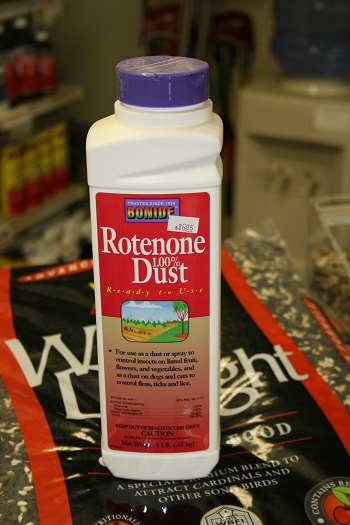
There is a perceived notion among the public that botanical pesticides (insecticides and/or miticides) or those derived from plants are “safer” than synthetically derived pesticides. However, nothing could be further from the truth, as plants produce some of the most toxic compounds to protect themselves from herbivores (insect and mite pests). Even though they are derived from plants, certain botanical insecticides may be highly toxic to humans. One of these botanically based insecticides that may be used in home gardens is rotenone, which has been used as an insecticide since 1848. Rotenone has insect and some mite killing activity; however, it is more effective as an insecticide.
One of the major concerns with rotenone is that it is highly toxic to fish. As such, rotenone should never be applied around ponds, lakes, and rivers. Rotenone is derived from the roots of either Lonchocarpus spp., or Derris spp. plants, which are primarily grown in Malaya, Venezuela, Peru, and East Africa. Rotenone is extracted from the roots of these plants and ground-up, and usually formulated as a dust.
Rotenone has both contact and stomach poison activity. It is slow acting but insect pests stop feeding immediately. Products containing rotenone as the active ingredient are labeled against a diversity of insect pests including aphids, sawflies, certain caterpillars (e.g., bagworms), beetles (e.g., Japanese beetle and flea beetles), leafhoppers, thrips, stink bugs, whiteflies, and some mites. Rotenone works by inhibiting the electron transport system in the mitochondria, which results in blocking the production of ATP (adenosine triphosphate). In other words, rotenone inhibits cellular respiration.
Rotenone has been registered in the USA since 1947 and is commercially available for use in gardens to deal with insect pests of vegetables, fruits, and ornamentals. Rotenone is sold containing 1% or 5% active ingredient as either a dust or powder. Dust formulations should only be applied when the wind is still. In some formulations, rotenone is combined with pyrethrins (e.g., pyrethrum); however, these products are not recommended because rotenone must be consumed by insects to be effective and the contact activity of the pyrethrins may reduce ingestion. Although rotenone is relatively non-toxic to bees (e.g., honey and bumble bees) it will kill beneficial insects such as parasitoids (parasitic wasps) and predators (e.g., ladybird beetles and lacewings) directly by contact.
Rotenone is not effective when the spray solution pH is >7.0. A synergist called MGK 264, which prevents insect pests from metabolizing insecticides, may be added to products to enhance the activity of rotenone. Rotenone is quickly degraded in soil and water, with persistence depending on exposure to environmental conditions. For example, rotenone is easily broken down under ultra-violet light resulting in a half-life between 1 and 3 days. Toxicity is 5 to 6 days when exposed to spring sunlight whereas toxicity is less (2 to 3 days) under summer sunlight. Because rotenone is rapidly broken down under sunlight it is best to make applications in the evening.
Rotenone is one of most acutely toxic botanicals with LD50 (lethal dose that kills 50% of the test population of rats) ranges from 132 to 1,500 mg/kg with variability due to differences in plant extracts. However, the oral LD50 is between 300 to 500 mg/kg; most typically cited as 350 mg/kg. Although this may be considered “moderately toxic” this is still more harmful than both carbaryl (Sevin) and malathion. Moreover, direct contact with rotenone may lead to irritation of the skin and mucous membranes. Rotenone was considered “safe” to use in organic production systems; however, due to recent studies that have linked possible rotenone chronic exposure to some forms of Parkinson’s disease in animals, it is no longer registered for use in organic production systems. In addition, studies have revealed that rotenone causes tumors in rats.
It is important to understand that just because pesticides are derived from plants (or are “natural”) it doesn’t mean they are “safer” to humans and other organisms. As such, always read the product label and exercise caution when applying any botanical pesticides.
Dr. Raymond A. Cloyd is a Professor and Extension Specialist in Ornamental Entomology/Integrated Pest Management in the Department of Entomology at Kansas State University.
Related Articles & Free Email Newsletter Sign Up
Azadirachtin and Neem: What is the Difference?
How To Identify & Manage Sowbugs and Pillbugs



Comment here